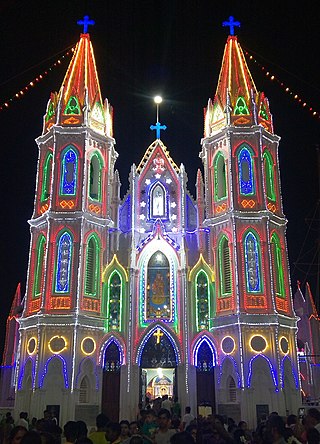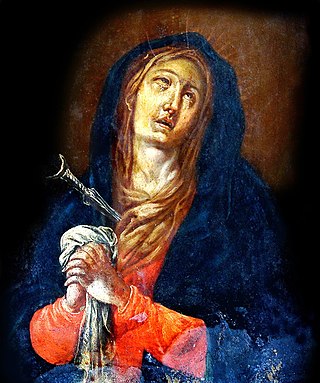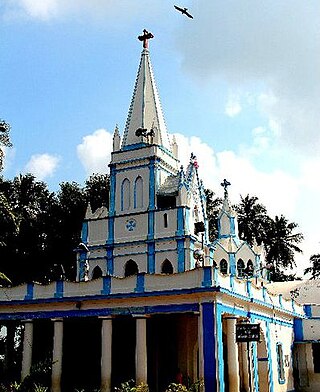Abbé J. A. Dubois or Jean-Antoine Dubois was a French Catholic missionary in India, and member of the Missions Etrangères de Paris; he was called Dodda Swami by the local people. In his work on Hindu manners, customs and traditions he presented Indian cultures, traditions, thoughts and the varnasrama system. He returned to France, and authored a book of Indology, Hindu Manners, Customs and Ceremonies.
The Bangalore Cantonment (1806–1881) was a military cantonment of the British Raj based in the Indian city of Bangalore. The cantonment covered an area of 13 square miles (34 km2), extending from the Residency on the west to Binnamangala on the east and from the Tanneries on Tannery Road in the north to AGRAM in the south. By area, it was the largest British military cantonment in South India. The British garrison stationed in the cantonment included three artillery batteries, and regiments of the cavalry, infantry, sappers, miners, mounted infantry, supply and transport corps and the Bangalore Rifle Volunteers. The Bangalore Cantonment was directly under the administration of the British Raj, while Bangalore City itself was under the jurisdiction of the Durbar of the Kingdom of Mysore.

The St. Mary's Syro-Malabar Cathedral Basilica is a cathedral in Ernakulam, Kerala, India. It was founded in 1112, and is also known by the names Nasrani Palli, Anchikaimal Palli or Thekke Palli. The church is the headquarters of the Major Archeparchy of Ernakulam-Angamaly, which is the Primatal See of the Syro-Malabar Church. Currently it’s closed down and under police protection due to dispute between the rebels in the Ernakulam-Angamaly diocese and the Syro-Malabar Hierarchy.

Our Lady of Good Health, also known as Our Lady of Vailankanni, is a title given to the Blessed Virgin Mary by devotees. She is said to have appeared twice in the town of Velankanni, Tamil Nadu, India, in the 16th to 17th centuries.

The Minor Basilica of St. Anne is a Roman Catholic church in Bukit Mertajam, Penang, Malaysia. It is one of the parishes in the Diocese of Penang. Its annual celebration of the feast of St Anne regularly attracts over 100,000 pilgrims from Malaysia and neighbouring countries including Singapore, Thailand, Vietnam, Indonesia, the Philippines and Australia. The celebration lasts for 10 days, and includes the actual feast day on 26 July.

St. George's Basilica or the Basilica and Collegiate Parish Church of Saint George, also simply known as San Ġorġ in Maltese, is a historic Baroque church situated in the middle of Gozo, the second largest island in the Maltese archipelago, and is surrounded by a maze of old narrow streets and alleys. The church had been rebuilt numerous times during the Middle Ages. Today's basilica was built between 1672 and 1678.

The Basilica of Our Lady of Good Health, also known as Sanctuary of Our Lady of Velankanni, is a Christian shrine located at the town of Velankanni, Tamil Nadu, India. The shrine is dedicated to the Blessed Virgin Mary.

Our Lady of Sorrows of Turumba is a Marian title, a venerated Marian icon and image associated to the Our Lady of Sorrows, The town of Pakil in the province of Laguna considers her as its patroness.

St. Michael's Church is one of the oldest Catholic churches in the Mahim suburb of Mumbai (Bombay), India.
Bangalore (Bengaluru), the capital of Karnataka state, India, reflects its multireligious and cosmopolitan character by its more than 1000 temples, 400 mosques, 100 churches, 40 Jain derasars, three Sikh gurdwaras, two Buddhist viharas and one Parsi fire temple located in an area of 741 km2 of the metropolis. The religious places are further represented to include the few members of the Jewish community who are making their presence known through the Chabad that they propose to establish in Bangalore and the fairly large number of the Baháʼí Faith whose presence is registered with a society called the Baháʼí Centre. In the demographically diverse, major economic hub and India's fastest-growing major metropolis of Bangalore, the number of religious places of each religion reported reflects growth in proportion to the population growth. According to the 2001 census of India, 79.37% of Bangalore's population is Hindu, roughly the same as the national average. Muslims comprise 13.37% of the population, which again is roughly the same as the national average, while Christians and Jains account for 5.79% and 1.05% of the population, respectively, double that of their national averages. Anglo-Indians also form a substantial group within the city.

St. Lawrence Shrine Basilica or Attur Basilica is a Roman Catholic church in Karkala, India. It was built in 1759 and is purported to be the site of many miracles. It is by characterized its Attur Jatre or Attur Festival.

The central business district of Bangalore is the area within a 6 km radius around Vidhan Soudha. This is the center of Bangalore and was founded by Kempegowda of the Vijayanagara Empire. Most of the land is used by commercial establishments and the Indian Army with plans of skyscrapers under works. It has multiple high-rises including World Trade Center Bangalore and UB Tower. It also includes heritage properties like the Bangalore Fort and the Bangalore Pete.

Our Lady of Peñafrancia is an image of the Blessed Virgin Mary. A Marian image is permanently enshrined in the Minor Basilica of Our Lady of Peñafrancia in Naga, Camarines Sur.

Shrine of Our Lady of Lourdes, Villianur, Puducherry is a Catholic Marian shrine and a parish church in Villianur, Puducherry, India. The shrine is dedicated to the Blessed Virgin Mary under the title of Our Lady of Lourdes.
The Karnataka Central Diocese is one of the twenty-two dioceses of the Church of South India covering the central part of Karnataka. The Church of South India is a United Protestant denomination.
Fraser Town, Bengaluru or Mootocherry, is a locality of Bangalore Cantonment, located in the central part of the city spread over 4 km2. It was established in 1906 and is named after Stuart Mitford Fraser (1864–1963), who was the tutor and guardian of Krishna Raja Wadiyar IV, Maharaja of Mysore. Fraser Town was established to de-congest the growing Bangalore Civil and Military Station. The foundation of Fraser Town was laid in August 1910 by Mrs. F J Richards, with a commemorative plaque on the corner of Coles Road and Mosque Road.

St. John's Church is located in St. John's Hill, Cleveland Town, Bangalore Cantonment, India, in between Promenade Road and St. John's Church Road. The church is the fourth oldest Protestant church in the city, with a distinct red edifice and towering steeple, rising out of the leafy surroundings. The church is dedicated to St. John the Evangelist.
The East Parade Church, consecrated in 1865, is located on Mahatma Gandhi Road, in the Bangalore Cantonment. The church comes under the Karnataka Central Diocese of the Church of South India. Started in the early 19th century as the Wesleyan Mission Chapel by Wesleyan believers of the Madras Army with Tamil and English services, the Church now has services in Tamil and Malayalam. The name East Parade comes from its location on the East of the Parade Grounds of the Madras Engineer Group (MEG) regiment. The present church building was raised in 1865, on the site of the old Wesleyan Mission Chapel, with an inscription dated 6 October 1863 marking the laying of the foundation stone.
Arthur Henry Cole was an Anglo-Irish politician and civil servant who sat in the British House of Commons for Enniskillen from 1828 to 1844.






















